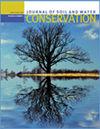Artificial intelligence for assessing organic matter content and related soil properties
IF 2.6
4区 农林科学
Q2 ECOLOGY
引用次数: 0
Abstract
Settled farming or agriculture has undergone several revolutionary periods ever since its start about 10 millennia ago (Jellason et al. 2021; Akinkuotu 2023). The first Agricultural Revolution was the transition from hunter-gatherer to the settled agriculture about 8,000 BC. The second Agricultural Revolution occurred between the seventeenth and nineteenth centuries when farm size increased, farm mechanization occured, and agricultural products were commercialized and traded. The third, or “Green Revolution,” began in the early twentieth century when genetically improved and dwarf varieties of cereals (rice [ Oryza sativa L.], wheat [ Triticum aestivum L.], and corn [ Zea mays L.]) were grown with heavy inputs of agro-chemicals (fertilizers and pesticides), leading to drastic increases in crop yield (Chakravarti 1973; Borlaug 2001; Hardin 2009), but severe adverse effects on the environment (John and Babu 2021). The Green Revolution had two interrelated stages: from 1960 to 2000 it was based on seed-centric technologies (Borlaug 2001), and 2000 to 2020s it was based on soil-centric technologies with focus on soil carbon (C) sequestration (Lal 2004), eco-intensification (Martin-Guay et al. 2018), impact (Evenson and Gollin 2003), and adaptation to and mitigation of anthropogenic climate change (Lal 2013; Lal et al. 2011; Muñoz and Zornoza 2018; Hou 2021). The soil-centric Green Revolution, based on judicious management of soil, crops, water, climate change, etc., paved the way for the use of artificial intelligence (AI), and thus transformation into a fourth Agricultural Revolution. The fourth revolution involves the use of AI during the early twenty-first century to address the challenges of agriculture. It is called …人工智能评估有机质含量及相关土壤特性
定居农耕或农业自大约 10 000 年前开始以来经历了几个革命时期(Jellason 等,2021 年;Akinkuotu,2023 年)。第一次农业革命是公元前 8000 年左右从狩猎采集向定居农业的过渡。第二次农业革命发生在 17 世纪到 19 世纪之间,当时农场规模扩大,农业机械化出现,农产品实现了商业化和贸易化。第三次农业革命,或称 "绿色革命",始于 20 世纪初,当时通过基因改良培育出了矮秆谷物品种(水稻[Oryza sativa L.]、小麦[Triticum aestivum L.]和玉米[Zea mays L. ]),并在种植过程中投入了大量的肥料。),并大量使用农用化学品(化肥和杀虫剂),使作物产量大幅提高(Chakravarti,1973 年;Borlaug,2001 年;Hardin,2009 年),但对环境造成了严重的负面影响(John 和 Babu,2021 年)。绿色革命分为两个相互关联的阶段:1960 年至 2000 年,绿色革命基于以种子为中心的技术(Borlaug,2001 年);2000 年至 2020 年,绿色革命基于以土壤为中心的技术,重点关注土壤固碳(Lal,2004 年)、生态强化(Martin-Guay 等,2018 年)、影响(Evenson 和 Gollin,2003 年)以及适应和减缓人为气候变化(Lal,2013 年;Lal 等,2011 年;Muñoz 和 Zornoza,2018 年;Hou,2021 年)。以土壤为中心的绿色革命基于对土壤、作物、水、气候变化等的合理管理,为人工智能(AI)的使用铺平了道路,从而转变为第四次农业革命。第四次革命涉及在 21 世纪初利用人工智能应对农业挑战。它被称为 ...
本文章由计算机程序翻译,如有差异,请以英文原文为准。
求助全文
约1分钟内获得全文
求助全文
来源期刊
CiteScore
4.10
自引率
2.60%
发文量
0
审稿时长
3.3 months
期刊介绍:
The Journal of Soil and Water Conservation (JSWC) is a multidisciplinary journal of natural resource conservation research, practice, policy, and perspectives. The journal has two sections: the A Section containing various departments and features, and the Research Section containing peer-reviewed research papers.

 求助内容:
求助内容: 应助结果提醒方式:
应助结果提醒方式:


